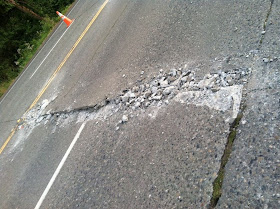But quite honestly this event was not that unusual west of the Cascades....the kind of heat wave we see a few times in a typical summer and such high temps are not that unusual in late June. I can prove this by showing a plot of daily records at Sea Tac. The yellow lines show the daily extremes. Low to mid 90s have occurred many days in June. So forget the theory that such an event is usual "so early in the summer." And you can not pin this on global warming.
So how hot did the concrete get yesterday and today? The Seattle Snowwatch website shows both air temperatures and roadway temperatures. Let's take a look for Sunday, the hottest day of the event (by the way, the forecasts were wrong about this....the predictions were for Monday to be the warmest....it was not).
At 1 PM, parts of I5 in north Seattle got to 115 and 120F (road temps are in the rectangle), and plenty of roads were 105-115F. Also notice the contrast in the city for air temperatures: while some locations were in the mid-80s, and parts of the east-side were in the upper 80s, low to mid 70s were available near the water. That is a wonderful thing about living here: you can virtually always escape the heat by going near our cool water. Can't do that in Phoenix!
Looking at a wider view at a time near the maximum temperature (5 PM), you can see that warmest locations Sunday were on the lower western slopes of the Cascades, where some locations hit 97F, with highs cooling towards the water. Around Victoria, high 60s and low 70s were enjoyed. Eastern Washington was only a bit warmer than the west, with a few stations hitting 100F.
This event never had the making of an historic heat wave because we never had sustained, strong offshore (easterly) flow. Thus, we lacked the extra warming that occurs as air descending the western slopes of the Cascades and is compressed. And this situation resulted form the high pressure area being too far to the east.
Yesterday, I went mountain biking with a friend and was in a place where the temperatures were in the mid to upper 40s, and where a light fog was evident. Guess where I was.
The Snoqualmie Pass rail tunnel. Really amazing place. But what was particularly neat was the visual shimmering that was apparent as the cold air from the tunnel mixed with the 85F air outside. Really interesting optical effect produced by the differing densities of the cold and warm air.
Finally, the cooling has already started on Monday night. The pressure is now several hPa higher on the coast than in the interior and marine air/low clouds are already pushing inland. Not an energetic onshore push, but enough to take the temps down 5-10F tomorrow. And another notch down on Wednesday. Comfortable temperatures return. July 4th looks like a perfect day...no rain and temperatures in the upper 70s. Can't do better than that.
And June ended up much warmer than normal (about 4F!) and a bit drier than usual. One of the least gloomy Junes I can remember lately.





Well, you're clearly talking about our neck of the woods and I don't disagree. But it was/is a historic event in the broader region.
ReplyDeletehttp://www.wunderground.com/blog/JeffMasters/show.html
And associated with another "interesting" jet stream wave form to add to the recent pile.
Hmmm. If we set an all-time record for a particular day in June, it's hard to understand how that's not an unusual day. Surely a record high for a particular day is interesting as much as anything because it's unusual, unprecedented, unique?
ReplyDeleteHow are "extreme" highs measured? (is it that the temperature reached that point for a moment in time, or an average for several minutes, or an hourly average during the day?)
ReplyDeleteI agree, it was the best June in some years. I only wish I hadn't been knocked off my bicycle and broken my hand (courtesy of a Bothell driver). Hands are useful for climbing and sailing... All you cyclists out there, beware suburban drivers. They cannot be trusted.
ReplyDelete